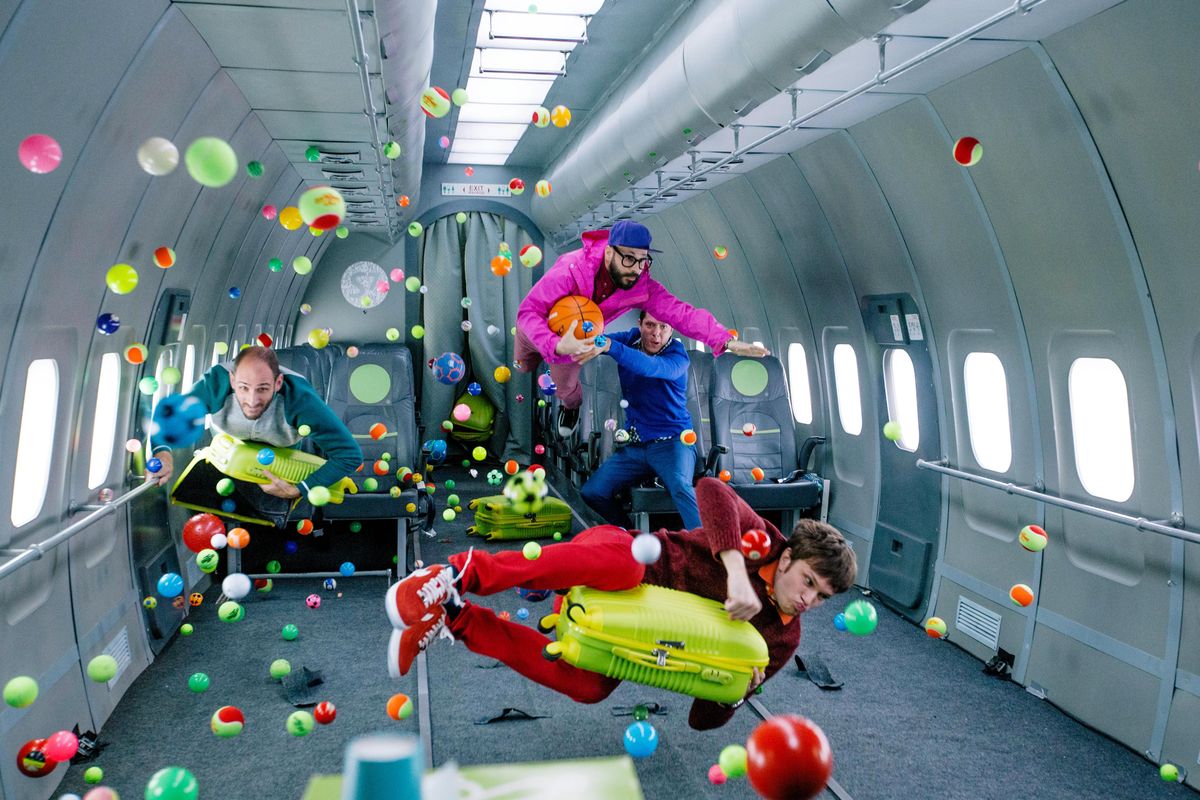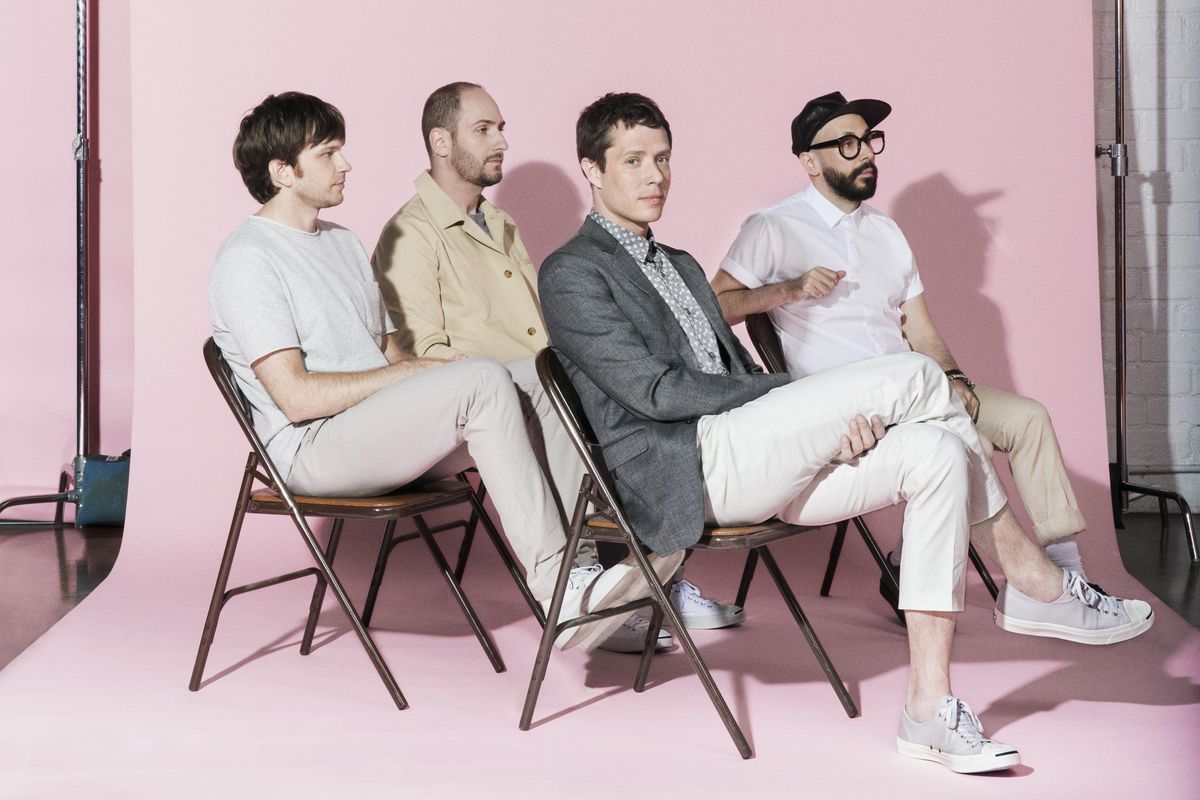Gravity is no challenge for OK Go’s creativity
OK Go performs in zero gravity in this scene from the music video for “Upside Down and Inside Out.” (Courtesy of Jim Flanagan)
It all started with eight treadmills.
When rock quartet OK Go released the video for “Here It Goes Again” in 2006, the clip of the band – Dan Konopka (drums), Damian Kulash (singer/guitarist), Tim Nordwind (bass guitar/vocals) and Andy Ross (guitar/keyboards/vocals) – performing a choreographed dance on treadmills went viral.
The video, which was filmed in one continuous take, had amassed more than 50 million views on YouTube at one point, and the re-uploaded video currently has nearly 38 million views.
The band performed the treadmill routine at the 2006 MTV Video Music Awards, and the video, directed by the band and Kulash’s sister Trish Sie, went on to win the 2007 Grammy Award for Best Short Form Music Video, and “Time” magazine named it one of the 30 all-time best music videos in 2011.
The band followed it up with a video for “WTF?,” which featured a delayed image effect, and two videos for “This Too Shall Pass,” one that featured the University of Notre Dame marching band and one that featured an elaborate Rube Goldberg machine made of more than 700 objects that transversed an estimated half-mile course through a two-story warehouse.
With each subsequent music video, OK Go pushes the bar higher and higher. Recent clips have included the band performing tricks with trained dogs and a goat (“White Knuckles”), creating optical illusions (“The Writing’s On the Wall”) and moving in zero gravity (“Upside Down and Inside Out”).
The latter video won OK Go and Sie the award for Visual Arts at the 2016 Smithsonian American Ingenuity Awards.
Completing “Upside Down and Inside Out” was particularly satisfying for Nordwind for a variety of reasons.
“The physics and math involved were both very challenging, and the physical and mental toll it took on us I think made coming out the other end feel all that much more victorious,” he said in an email. “I love the way the video turned out and I’m not sure we’ll ever make something quite like that again.”
For its latest one-shot video, “The One Moment” off last year’s “Hungry Ghosts,” the band filmed 4.2 seconds of real-time footage that featured 300 different events that was then slowed down to play the length of the song.
As the band explained earlier this year in a TED Talk called “How to Find a Wonderful Idea,” its video concepts often start out from playing around in sandboxes of untried ideas.
With no one set idea in mind, the band will try everything it can and essentially see what happens.
“There can be so much chaos at the sandbox level that I think everyone is looking for an ‘a ha’ moment where something is so awesome that no one can deny it in the room,” Nordwind said. “How do we know that moment? Hard to say. It’s just kind of a feeling we get, a look in everyone’s eyes that says ‘Oh yeah, that’s a special thing that just happened.’”
Depending on the video, the process of concept to completion can takes anywhere from a week (“Here It Goes Again”) to several months (“Upside Down and Inside Out,” “The Writing’s On the Wall”).
But before there can be music videos, there needs to be music.
According to Nordwind, the music has always been the foundation on which all of OK Go’s other creative projects have been built.
“Songwriting and producing sort of happen on a separate creative island from the videos, for us,” he said.
When in the studio, the band focuses on music exclusively. Once the record is finished, they hit the sandboxes and try to imagine the wildest video concepts possible. Then it’s a matter of seeing what song makes the most sense for each concept.
No matter the concept, working on the visual side of a song changes how Nordwind both hears the song and sees the video.
“The marriage of sight and sound always changes my perspective on both.” he said. “The most exciting part about a final piece is that there’s a new elevated experience that I couldn’t have imagined until the elements were combined.”
With not even gravity holding him back, Nordwind said he never worries about reaching creative plateaus and instead focuses on creating things he and the band find interesting, hoping others find them interesting, too.
The band’s latest endeavor finds it live scoring its music videos during a series of performances scheduled for the fall and into next year.
The idea came about after Nordwind watched the 1931 silent film “Dracula” accompanied by the Kronos Quartet performing Philip Glass’s score for the film live.
“I remember thinking how cool it was to experience such an iconic film on the big screen with a larger (than) life soundtrack,” he said. “My experience with ‘Dracula’ was always on TV with fairly canned sound so to see it on the silver screen was an incredible experience.”
The performance got Nordwind thinking about how OK Go music videos are often seen on a phone or computer screen at best. He then realized they could apply the same idea behind the live scoring of “Dracula” to the videos.
“It got me realizing that wait … We make fairly iconic films… And wait… We compose all the music for it too… AND WAIT… We could make our own show playing in synch to our own videos on the big screen,” he said. “If you’re between the ages of 3-130, I totally recommend it.”
With new music and music videos in the works, OK Go is creating both an audio and visual legacy.
And whether remembered more for its songs or music videos, Nordwind said OK Go will be happy just to be remembered.
“I think the importance for us is in the creation of the things that we make,” he said. “And the hope that what we make will be inspiring to others and to ourselves.”

